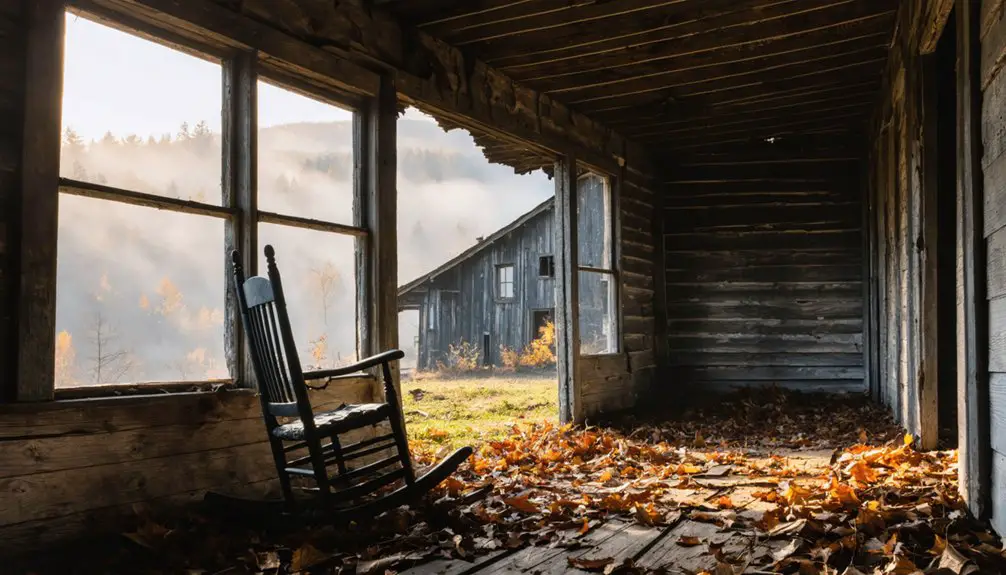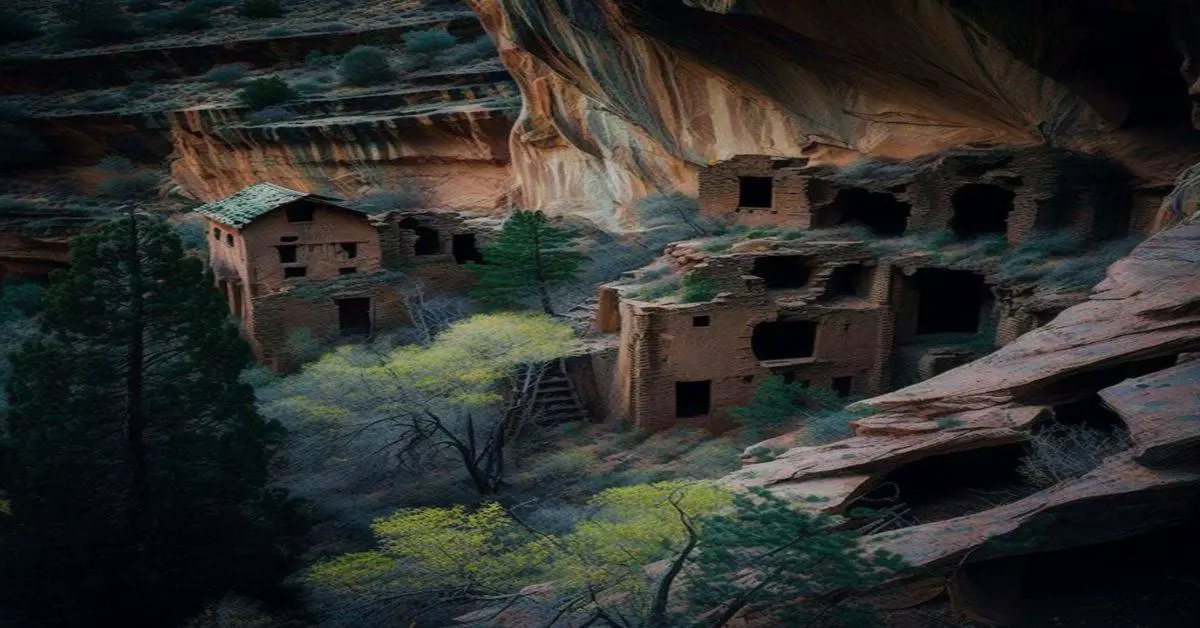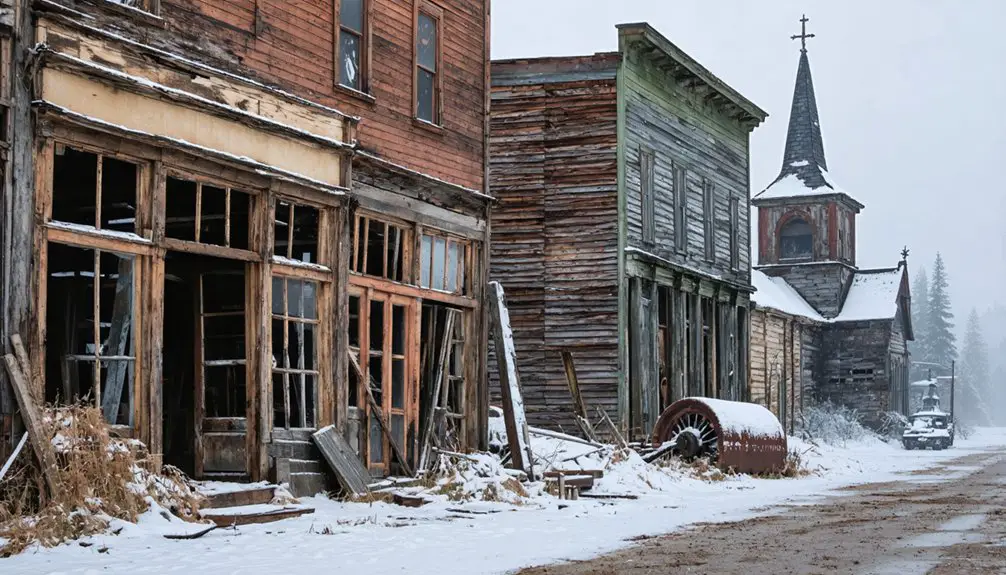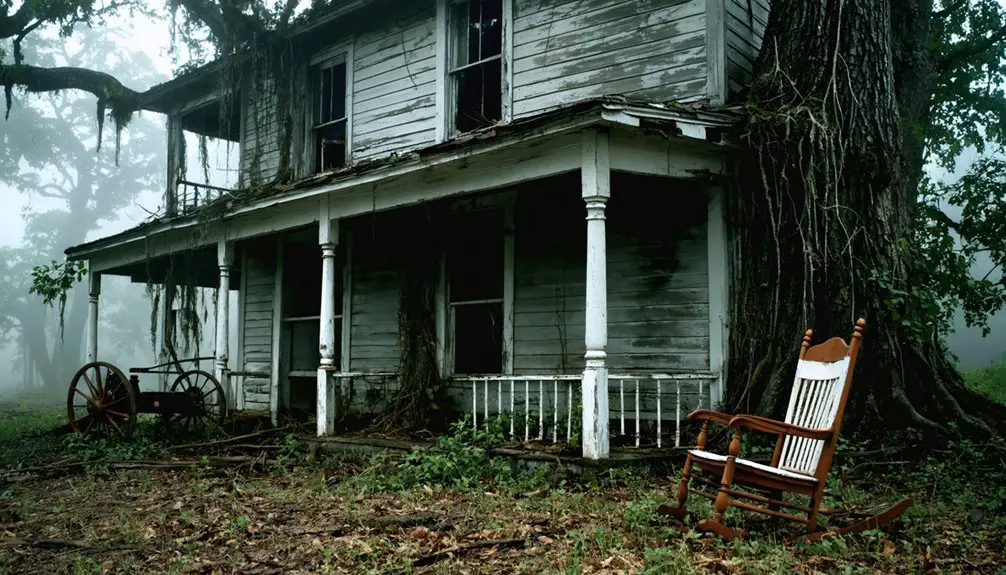You’ll discover Royal perched along West Virginia’s New River Gorge, where an innovative aerial tramway once transported coal across the steep terrain from 1890 to 2020. This former mining community thrived through its connection to nearby Prince, with miners working 10-12 hour shifts and families relying on the company store’s scrip system. Today, the abandoned town’s infrastructure has been reclaimed by nature, though its tramway foundations and cable towers stand as silent sentinels to America’s industrial heritage.
Key Takeaways
- Royal was established in 1890 as a coal mining town by the Royal Coal and Coke Company in Raleigh County, West Virginia.
- The town’s distinctive aerial tramway system transported coal across the New River Gorge to Prince for processing and shipping.
- Coal production declined 65% between 2005-2020, forcing families to abandon homes and seek employment elsewhere.
- Most of Royal’s infrastructure has been reclaimed by nature, with only tramway foundations and cable towers remaining as historical markers.
- The ghost town is now part of New River Gorge National Park, preserving its mining heritage through remaining artifacts and structures.
The Birth of a Mining Town
While much of southern West Virginia remained sparsely populated in the late 1800s, the establishment of Royal in 1890 marked the beginning of Raleigh County’s coal mining era.
Brothers-in-law James Kay and James Laing brought their founding vision to life when they developed the Royal Coal and Coke Company on the south bank of the New River.
You’ll find the story of Royal’s beginnings rooted in transformation. Before the coal mine’s arrival, you’d have seen only scattered independent farmers working the land.
A Scottish immigrant established the town in the decades before the mine opened, setting the stage for its industrial future.
But community challenges didn’t stop Kay and Laing from pushing forward. They built the region’s first commercial coal operation, linking Royal’s destiny to the town of Prince across the river.
Soon, company buildings rose from the wilderness, and about 75 houses sprouted up to shelter the miners who’d power this new industrial frontier.
The mine began coal production in 1891, enabling distribution of coal resources beyond the New River Gorge region.
Life Along the New River
Life along the New River shaped every aspect of Royal’s frontier existence. You’d have found yourself amid one of North America’s oldest river valleys, where dense forests teemed with deer, turkey, and bear.
The river’s deep gorge created rich bottomlands where early settlers built their homes and worked mixed farms, supplementing their harvests with abundant wild game.
The river ecology supported both daily survival and commerce, as you could’ve traded furs or mined coal while living off the land. The earliest settlers like Adam Harman established their homesteads near natural springs for reliable water sources.
Your cultural heritage would’ve been deeply rooted in the tight-knit community spirit of the frontier, where neighbors helped each other clear land and build fortifications. The Great Indian Warpath once passed through this very gorge, serving as a vital corridor for early travelers.
The Southern Trail, once an Indigenous pathway, would’ve connected you to distant markets while the river itself served as your lifeline to the wider world.
Engineering Marvel: The Aerial Tramway
You’ll find Royal’s aerial tramway was a remarkable feat of engineering, using the Trenton-Bleichert system to transport coal across the New River gorge where no bridge existed.
The tramway’s half-ton buckets operated on a gravity-powered counterbalance system, with loaded cars pulling empty ones uphill at a designed capacity of 80 tons per hour. Today’s modern trams at Hawks Nest and Pipestem use pulse gondola systems for increased efficiency.
Similar to modern aerial tramways that use concrete counterweights, workers regularly inspected the wire cables, towers, and sheaves while managing the coal separation process at the tipple where the coal was sorted into lump, nut, and slack categories.
Design and Construction Challenges
When Royal’s engineers faced the challenge of moving coal across the New River Gorge in the early 1900s, they turned to an innovative solution: the Trenton Bleichert Aerial Tramway system.
The design innovations required installing robust support towers on treacherous terrain while spanning an 800-foot elevation difference between the mine and unloading site. Though Royal Riblet was often credited, it was his brother Byron Riblet who pioneered these tramway innovations. Like the Vanoise Express in France, the system could transport heavy loads using sophisticated double-decker technology.
The system didn’t need a bridge – instead, it relied on specialized steel cables and iron towers to create a direct aerial route.
The engineers had to overcome the complex task of building terminal stations at vastly different heights while ensuring the cable system could handle continuous heavy loads.
They incorporated safety features to prevent cable failures and used materials specifically chosen to withstand harsh industrial conditions.
Daily Operations and Maintenance
The daily operations of Royal’s aerial tramway centered on three critical functions: coal transport, personnel movement, and rigorous maintenance protocols.
You’d find loaded coal buckets descending 800 feet down the gorge while empty ones climbed up, creating an efficient counterbalance system that could move 80 tons per hour. Miners bravely rode these same buckets above the New River’s treetops to reach their workplace.
The aerial tramway operations demanded constant attention to safety and upkeep. You’d see crews regularly inspecting wire cables, lubricating pulleys, and maintaining support towers. This rigorous inspection system was a precursor to modern tram safety, which now allows operations in winds up to 54 mph.
When winds exceeded 24 mph, operations would halt. The tipple below sorted coal into different grades while maintenance teams cleaned coal dust from mechanical components to prevent failures and fire risks.
Daily Life in Royal’s Prime
If you’d visited Royal during its prime in the 1890s, you’d have witnessed coal miners heading to work in shifts, gathering their equipment before descending into the county’s first underground mine.
You’d have seen wives and children maneuvering between company housing and independent stores, mixing business with social calls in this close-knit mining community.
Beyond the daily grind of mining life, families relied on the Chesapeake & Ohio Railroad‘s frequent service to access entertainment and services in nearby Thurmond, where they could bank, shop, or enjoy the opera house. The town’s National Bank of Thurmond managed an impressive $4.8 million in yearly transactions during the late 1920s, showcasing the region’s economic vitality.
Mining Workers’ Daily Routines
Deep beneath Royal’s hillsides, miners endured grueling 10 to 12-hour shifts that often began before dawn and stretched into dusk.
You’d find yourself starting each day with a dangerous commute, suspended in coal buckets high above the New River gorge via the Bleichert aerial tramway system. Despite minimal safety practices, you’d coordinate with your crew to maintain steady production flow.
Inside the mine, you’d work alongside fellow miners extracting coal by hand or machine, while support workers like blacksmiths and timbermen kept operations running.
If you weren’t digging coal, you might’ve been loading buckets, maintaining equipment, or managing ventilation systems. The foreman would oversee your shift, ensuring quotas were met as coal moved efficiently from Royal’s mines across the river to Prince’s railway station.
Domestic Town Life
Living in Royal during its prime meant adapting to a tightly controlled company town existence, where your daily routines revolved around the coal company’s schedule and resources.
You’d manage your household with supplies from the company store, using scrip instead of regular currency, while dealing with the isolation of a town separated from Prince by the New River’s challenging ferry crossing.
Your family’s survival depended on strong community bonds, as neighbors helped each other through domestic struggles.
You’d send your children to the basic company school, rely on home remedies when illness struck, and gather at church functions for social relief.
Without a bridge or easy access to outside services, you’d learn to be resourceful, making do with limited amenities while supporting your miner’s grueling work schedule.
The Prince-Royal Connection
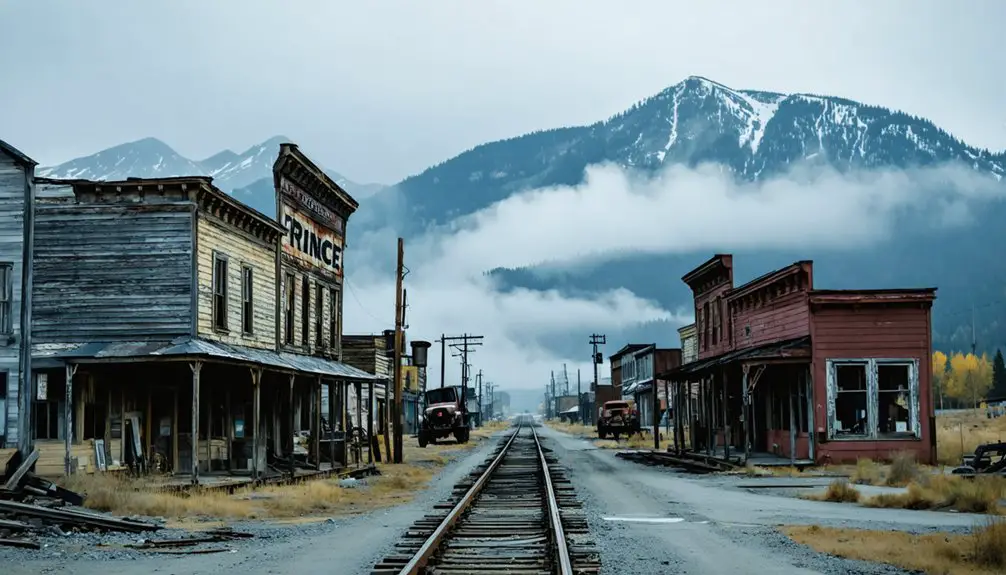
While separated by the New River, the coal towns of Royal and Prince developed a symbiotic relationship that shaped their shared destiny in the 1890s.
You’ll find their economic interdependence reflected in the daily movement of workers who commuted between the towns, relying on the Woods family ferry service to cross the river.
Transportation challenges didn’t stop the towns’ growth. The innovative aerial tramway, installed by Trenton Iron Company in 1890-91, carried coal from Royal’s mines directly to Prince’s railroad facilities.
An aerial tramway, engineering marvel of its day, ferried coal across the New River between Royal and Prince, overcoming nature’s obstacles.
William Prince himself bridged both communities as Prince’s founder and a Royal Coal and Coke Company shareholder.
In Prince, eighty coke furnaces processed Royal’s coal, while the C&O Railroad’s main line provided the essential shipping route that made both towns prosper.
Decline of a Coal Empire
As West Virginia’s coal industry reached its zenith in 1997 with 181.9 million short tons, Royal’s once-bustling mines faced an unprecedented decline that would reshape the region’s economic landscape.
Like many coal communities, Royal’s decline narrative mirrors the broader economic repercussions that swept through the state’s mining regions.
You’ll find these stark transformations in Royal’s story:
- Production plummeted 65% between 2005-2020, leaving abandoned mines scattered across the landscape.
- Automation replaced manual labor, forcing skilled miners to seek work elsewhere.
- Coal prices crashed 71% from 2011-2016, devastating local businesses and service economies.
- Communities transformed into ghost towns as families left, leaving behind empty homes and shuttered storefronts.
Legacy in the New River Gorge
Today Royal’s legacy endures through its innovative aerial tramway system, which revolutionized coal transport across the New River Gorge during the late 19th and early 20th centuries.
You’ll find this cultural significance preserved within the New River Gorge National Park, where metal artifacts, stone walls, and relocated gravestones tell the story of industrial innovation that shaped Appalachia’s mining history.
The town’s pioneering 665-foot cable system spanning the New River stands as a symbol of local entrepreneurship and engineering prowess.
While nature has reclaimed much of Royal’s infrastructure, you can still explore the tramway foundations and cable towers that showcase how the town’s leaders adapted to challenging terrain.
As part of the National Park, Royal’s remnants continue educating visitors about the region’s rich coal mining heritage.
Frequently Asked Questions
What Natural Disasters or Accidents Occurred in Royal During Its Operation?
You’d witness frequent flood events forcing cemetery relocations near the New River, while the dangerous coal mining operations likely experienced typical mining accidents during Royal’s industrial peak around 1890-1920.
Are There Any Surviving Photos of Royal’s Original Buildings and Infrastructure?
Less than 10% of Royal’s original structures remain in photos today. You’ll find mostly black-and-white images of stone walls and mining artifacts through historical documentation and ghost town exploration records.
What Happened to the Mining Equipment After Royal Was Abandoned?
You’ll find most mining equipment was left behind due to the remote location’s challenges. The aerial tramway and machinery gradually deteriorated, with no historical preservation efforts undertaken to salvage these industrial remnants.
Did Any Notable Historical Figures or Celebrities Ever Visit Royal?
You won’t find any records of famous visitors or celebrity sightings in Royal’s history. The town’s notable figures were limited to local industrialists like James Kay and James Laing.
Were There Any Schools or Churches Established in Royal?
You’ll find the schools history and church significance of this town largely undocumented, though like most coal camps, it probably had basic community institutions serving miners’ families during its operational years.
References
- https://www.youtube.com/watch?v=yBKOIRxeNX0
- https://www.onlyinyourstate.com/experiences/west-virginia/sewell-in-wv
- https://www.youtube.com/watch?v=tU8B0h6jGdU
- https://theclio.com/entry/134486
- https://www.nps.gov/neri/learn/historyculture/royal.htm
- https://minesafety.wv.gov/historical-statistical-data/mining-in-west-virginia-a-capsule-history/
- https://en.wikipedia.org/wiki/Coal_camps_in_Raleigh_County
- http://www.kinyon.com/westvirginia/midnewriver/chapter1.htm
- https://www.familysearch.org/en/wiki/New_River_and_Southern_Trail
- http://freepages.rootsweb.com/~genbel/genealogy/octnov/newriver.html
